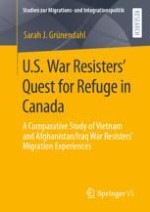When U.S. war resisters turned to Canada as refuge during the Vietnam War and the Afghanistan/Iraq Wars, they not only hoped to forestall deployment to a combat zone but also to build new lives and make a new home abroad. In her empirical study, Sarah J. Grünendahl explores and juxtaposes how well the two war resister 'generations' have been able to establish themselves after all and to what extent they partake in Canadian society.The comparison is instructive for migration and refugee studies altogether: The war resisters in the sample, unlike many other migrant populations, did not have to contend with language and cultural barriers in their destination country, given similarities between the United States and Canada. Sarah J. Grünendahl's research thus allows for an analysis of the effects of residency on migrants' adaptation and participation in the receiving society, isolated from these two common barriers. Further, the study sheds light on how refugees and non-citizens can employ civic engagement to claim a place for themselves and overcome societal exclusion.
